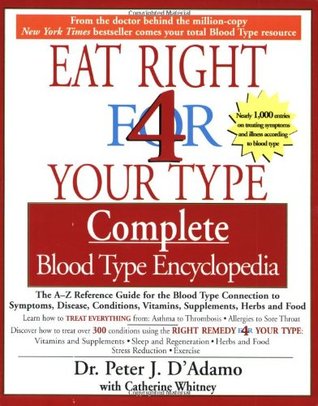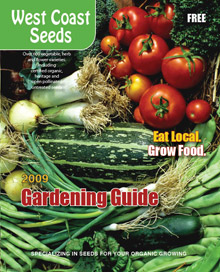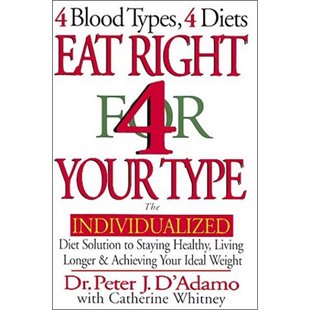 If you are intrigued by the concept of Eat Right 4 Your Type (as in blood type, see my review and related post), Dr. Peter D’Adamo’s related book, Eat Right 4 Your Type Complete Blood Type Encyclopedia: The A-Z Reference Guide for the Blood Type Connection to Symptoms, Disease, Conditions, Vitamins, Supplements, Herbs and Food, provides additional in-depth food for thought, particularly around the biological and evolutionary changes that may have influenced the blood/digestion link. (Unfortunately, the title also goes rather in-depth; try saying that without taking a breath.) Continue reading
If you are intrigued by the concept of Eat Right 4 Your Type (as in blood type, see my review and related post), Dr. Peter D’Adamo’s related book, Eat Right 4 Your Type Complete Blood Type Encyclopedia: The A-Z Reference Guide for the Blood Type Connection to Symptoms, Disease, Conditions, Vitamins, Supplements, Herbs and Food, provides additional in-depth food for thought, particularly around the biological and evolutionary changes that may have influenced the blood/digestion link. (Unfortunately, the title also goes rather in-depth; try saying that without taking a breath.) Continue reading
Category Archives: Books
Eating the Right Kinds of Food for YOU
I started this blog because I wanted to talk about eating more healthfully and in a way that is also healthful for the earth. You know, how our food choices impact us as well as the greater community a.k.a. the whole environmental thing. On the topic of how food choices impact us individually, and me specifically, I recently read Eat Right 4 Your Type and posted the following review on GoodReads.com:
After once again encountering serious digestive issues despite years of choosing healthy options (very little wheat, virtually no dairy, no caffeine, no soft drinks, choosing whole foods vs. packaged, limiting sugar etc.) and several cleanses, I’m intrigued by the idea that part of the key to my challenges may be to understand how blood type affects digestion. I’m willing to give it a go — am in fact giving it a go — but do so with some caveats to D’Adamo’s approach.
The information on blood type evolution is fascinating (see my review under Eat Right 4 Your Type Complete Blood Type Encyclopedia) and makes a great deal of intuitive sense, as well as being backed up by plenty of research. No problem there.
However, I do feel like the food recommendations are dated. For instance, they don’t take into consideration what we now know about the non-food-like chemical composition to genetically modified foods, which surely must also affect how things like soy and wheat affect one’s blood. I find it disturbing that a doctor of naturopathic medicine doesn’t focus at all on discussing the quality of the food being chosen. Not once do I see any mention of the dangers of choosing non-organic soy products, for example, or the value of pesticide-free foods.
It’s also concerning that there is no focus on maintaining one’s overall digestive system as a key element in maintaining one’s health. It may be that some people already know about that, but it bears repeating for the countless people who will not take the time to educate themselves and will buy the book as the next great quick-fix.
I feel D’Adamo’s research is also outdated in its fanfare around the genetic basis for disease. We all got excited about the idea that once the DNA code was cracked we’d be able to eradicate disease. I don’t know if you’ve noticed, but there hasn’t been a pot of gold at the end of that rainbow. It turns out that DNA does not, on it’s own, solve the mystery and is not the miracle discovery everyone thought it would be. Dr. Bruce Lipton (The Biology of Belief) and others’ subsequent research in epigenetics shows that DNA provides a response to its environment but does not in fact control which genes are turned off and on.
All in all Eat Right 4 Your Type may be a piece of the puzzle, but like any other packaged solution it is not THE answer. We need to become knowledgeable about our bodies, how they work, and bring together knowledge from many disciplines to support our body in healing and maintaining health.
An Evening with a Lunatic Farmer
In collaboration with UBC Farm, Barbara-Jo’s Books to Cooks is pleased to announce a fund raising evening with Joel Salatin, holistic farmer, author, educator and activist. Join them for an educational, humourous and inspiring evening with Joel as he discusses his family’s logical, “beyond organic”, sustainable approach to farming, and his new book, The Sheer Ecstasy of Being a Lunatic Farmer.
Monday, September 27, 2010 @ 7:00 pm
H.R. MacMillan Building, 2357 Main Mall, UBC Map
On Polyface Farm in the Shenandoah Valley, Virginia, Joel and his family nurture a non-industrial, food production oasis. Instead of conventional methods of farming that include overcrowding, medication and processed feeds, the Salatins debunk all conventional food production with their refreshing paradigm that respects the natural physiology of animals, the land, the rhythms of nature and human connectedness to it all. A key personality in documentaries such as Fresh and Food Inc. and in Michael Pollan’s book, The Omnivore’s Dilemma, Joel has been instrumental in supporting a new sustainable food production movement.
Tickets for this event are $45 and will include a signed copy The Sheer Ecstasy of Being a Lunatic Farmer. Proceeds of ticket sales benefit UBC Farm. Tickets are available exclusively through Barbara-Jo’s Books to Cooks. Please call 604-688-6755 for more information and to purchase tickets.
Eat Well, be a Skinny Bitch
I read the NY best seller Skinny Bitch on the weekend expecting a cheeky, “Get your sorry ass off the couch” message. I did get that, but got even more in the way of “Stop eating crap, dumbass.”
“If you can’t take one more day of self-loathing, you’re ready to hear the truth: You cannot keep shoveling the same crap into your mouth every day and expect to lose weight.”
The book was just as cheeky as I’d hoped, but also full of tons of research and data on what’s in our “food” and why it pays to take note of what we put in our mouths. I like that it was a quick, easy read and focuses not on guilt or high minded environmentalism, but on base vanity. Frankly, whatever motivates the masses!
The book’s focus is more on organic than strictly “local” and they promote a lot of processed organic foods, but the message to eat more fruit and veggies aligns with sourcing healthy, local food. And if that gets the same result, it works for me.
Newbie Gardener Guide
I knew after reading Food Security for the Faint of Heart I was in for a treat with Gardening for the Faint of Heart.
Interspersed with lots of her typical humour, Robin Wheeler has another winner on her hands. I’m a newbie, Bumbling Gardener this year, so her advice on which beginner steps to try and which advanced activities to avoid were really helpful. Her style is calming, pragmatic and entertaining and the book is absolutely crammed with easy to read gardening info.
My favourite chapter was Edible Landscape, a window into seeing your whole yard for it’s food and fruit-bearing potential.
I must say I NEVER thought I’d read a gardening book at all, let alone for before bed relaxation.
West Coast Seeds
 The guru of west coast organic gardening and seed selection is West Coast Seeds. I’ve heard the name uttered in hushed, reverent, gardener-in-the-know tones particularly in reference to the annual West Coast Seeds free Gardening Guide.
The guru of west coast organic gardening and seed selection is West Coast Seeds. I’ve heard the name uttered in hushed, reverent, gardener-in-the-know tones particularly in reference to the annual West Coast Seeds free Gardening Guide.
If you want access to non-Monsanto-interfered-with seeds, these folks are your local source.
Not only do they have over 600 vegetable, herb and flower seed varieties, they have the envied, must-have, Planting Chart for Coastal BC on page 6. The catalogue/guide is filled with gardening tips, organic pest solutions, and other misc. gardening information that make it worth its weight, even if you buy your genetically modified seeds from the local hardware store or nursery.
If you can’t get down to their Delta location (must have car and up-to-date map!), by all means check them out online, request the catalogue, and order your seeds by mail. If you can get to the store, you’ll be treated to a wide variety of books, tools, garden enhancements (i.e. bee houses), and friendly advice to assist in your organic gardening endeavours.
Oh, and sign up for their newsletter, which is also full of timely planting tips — seasoned and novice gardeners alike will want to know what West Coast Seeds has to say.
PS: The website is a goldmine of information, peruse only when you have plenty of time to “waste”.
Note: (Jan 2010) I get periodic comments from individuals asking or accusing West Coast Seeds of selling GMO and/or Monsanto seeds. Frankly, from the comments I see it feels a bit like an urban myth that won’t die. However, Local Delicious makes no claims and is not a representative of West Coast Seeds. If you have questions, please contact WCS directly. If, on the other hand, you have proof of misdoing, we’re happy to talk…
Great Info Source: Ecoholic
When I first started looking in to possible environmental triggers for a few health issues I was experiencing, I came across a fab little book called Ecoholic. It has become an indispensable tool in my arsenal.
Written by Canadian author Adria Vasil, Ecoholic covers a wide variety of topics from personal health products to household cleaners to kids toys. It also includes a comprehensive section on food which explores:
- food labels (I constantly refer to this section)
- industrial agriculture, pesticides, and the environmental benefit of a local diet
- food packaging and gives tips on its safety (for you and for Earth)
- the working conditions in some of the world’s most popular crops such as coffee and chocolate — yes, child slavery is in full force at many chocolate plantations
- the growing prevalence of organic wines
What I truly appreciate in this book is that it isn’t just a “what not to do” manual — although there is A LOT to not do — but Adria gives specific suggestions for better, more healthy options. Yes, she names brands!
So, if you’re looking for a good, all around reference for a greener, more responsible lifestyle, I recommend starting with Ecoholic.
Did You Know?
Coffee is actually supposed to be grown under the thick rainforest canopy, not in squished rows out in the blazing sun? Imagine how fantastic the first coffee tasted?
Food Security for the Faint of Heart
I met Robin Wheeler, author of Food Security for the Faint of Heart this weekend, giving a presentation at the Vancouver City Farmer urban gardening information centre. In her discussion about the book, it struck me that what she calls “food security” is really just the “stocking up for winter” that my mother and grandmothers did on a regular basis.
The book starts with an earthquake scenario, a bit of shock and reality to catch people’s attention, but many of the things she writes about, including her gardening tips and tricks, would help any family that wants to take full advantage of the garden plot out back in the yard.
It’s an easy, humourous read absolutely full of useful information that no home gardener/home canner should be without.
Last Chance to Eat
 I am just over half way through Last Chance to Eat by Gina Mallet, a light and entertaining while impactful read on how much food production has changed over the last 100 years or so. While it may seen that we have reached the place of high volume, low quality food overnight, in reality the seeds were sown many years ago and fueled by war and post-war food shortages.
I am just over half way through Last Chance to Eat by Gina Mallet, a light and entertaining while impactful read on how much food production has changed over the last 100 years or so. While it may seen that we have reached the place of high volume, low quality food overnight, in reality the seeds were sown many years ago and fueled by war and post-war food shortages.
I am enjoying how Mallet’s personal history is interwoven with interesting details on the progression of food eaten from our back yard to food sourced in far away places. I find myself in turns salivating at the description of delicious meals and horrified at how we’ve come to fear food rather than respect, value, and appreciate it.
We’ve somehow lost the joy of savouring the surprise that comes from eating food that offers variety and nuances in flavour in favour of a consistency of texture and taste that is actually rather void of flavour. How did THAT happen?!
In the business realm, the McDonald’s model of providing consistent product is held up as the pinnacle of success. If you can create a business machine that chugs along on automatic, creating exactly the same thing you created yesterday you’ve “made it” and success will surely follow.
I buy that on a customer service and product value model – customers should consistently get good treatment and good quality products. That’s what a quality brand delivers. But I’m reconsidering the value of the mass-produced model when it comes to what I put in my mouth.

